Hexagonal Water
Are you
drinking dead water?
|
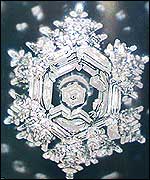
Only healthy water can form beautiful
hexagonal snowflake-like crystals. Snow water, water in fruits and
vegetables, cold water from deep wells and pristine streams - all have
the ideal hexagonal structure. |
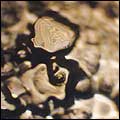
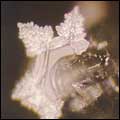
Tap water cannot form
crystal hexagonal structures even when it freezes. Of all
water’s properties, its hexagonal structure is probably the most
important, but is also the most fragile. It is easily destroyed by
environmental contaminants and modern water treatment processes.
|
The Structure of Water Determines Our
Health
Water molecules are made of one oxygen atom and two hydrogen atoms (H2O).
The relationship between these atoms gives water a unique electrical
polarity. Water’s unique ability to form and transform; create and
recreate; penetrate and dissolve anything it touches; and to collect and
deposit information wherever it flows is what gives all living things
their vital dynamism.
Water molecules bond easily with other molecules. In other words, water is
extremely “sociable”. It eagerly seeks to mingle with other elements and
gladly picks up “hitchhikers”. This is a great feature if the water picks
up good things like rich nutritious minerals and life-giving oxygen, but
it’s a very bad thing when it picks up toxic pollutants, nasty chemicals
or disease-causing organisms and then enters your bloodstream!
Hexagon Water is:
Instantly absorbed
The smaller the molecular clusters, the easier water will penetrate your
cells. One way to measure the size of the molecule clusters is using
Nuclear Magnetic Resonance Technology (NMR). The lower the NMR reading,
the smaller the clusters. Hexagon water has a certified NMR reading of
only 42.3Hz*. Normal tap water, RO and distilled water have readings
around 128Hz while bottled mineral water reads between 90 and 100Hz.
*National Tsing Hua University Report No. GMC 0203001 dated 28th March
2002.
You can test the absorption rate for
yourself. Try drinking two to three glasses of Hexagon water in one go.
You’ll notice that you don’t feel too full or nauseous because your body
is able to absorb and use Hexagon water instantly. -SOURCE
What is Hexagonal
Water?
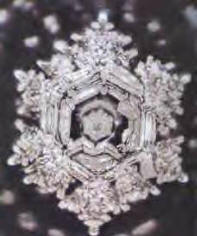 Hexagonal
Water is a specific arrangement of
individual water molecules where 6 H2O units consistently link to form a
ring-like structure. This unique arrangement is the basis of a more
complex crystalline network that is formed when numerous hexagonal units
join together.
Hexagonal
Water is a specific arrangement of
individual water molecules where 6 H2O units consistently link to form a
ring-like structure. This unique arrangement is the basis of a more
complex crystalline network that is formed when numerous hexagonal units
join together.
All water
contains a certain percentage of hexagonal
units – some sources more than
others. The percentage of hexagonal units appears to depend on a number
of factors, including the energetic influences that water is exposed
to. For example: chlorine, fluoride and many pollutants
typically found in municipal water sources reduce the number of hexagonal
units. Tap water typically has a very low percentage of hexagonal
structures.
On the other
hand, there are a number of places throughout the world where the water
has a high concentration of hexagonal structures. Many of these places
are known as “healing springs.” (Many people have heard of Lourdes, France
- a prime example) Others are known for producing inhabitants that live
long and disease-free lives.
How do we know when water is hexagonally
structured?
Nuclear Magnet
Resonance (NMR) is one of very few methods that can verify molecular
size. NMR analysis shows that ordinary tap water is composed of large
molecular units (between 12 and 20 individual H2O units). These
unorganized
molecular conglomerations are not nearly as supportive of biological
functions as Hexagonal Water
is now being shown to be.
Hexagonal Water
moves easily into the cellular environment
There is
significant evidence that
Hexagonal Water
moves within biological organisms with greater ease. It appears
to enhance nutrient absorption and the removal of metabolic wastes. (Many
who consume Hexagonal Water report a cleansing
reaction within days or weeks.) This may be due to the smaller size of
the molecular unit and its ability to enter and exit the cellular
environment with greater ease. It may also be due to the specific
organization of the hexagonal network which appears to enhance cellular
communication and to support other structures within biological
organisms.
|
"Hexagonal Water
is found surrounding healthy DNA, whereas unorganized water is found
surrounding the DNA of diseased tissue."
--
Jhon, M.S.,
The Water Puzzle and the Hexagonal Key |
Hexagonal Water
enhances metabolic efficiency
There is also
evidence that Hexagonal Water activates enzymes
to a greater degree than ordinary water – and that it enhances metabolic
efficiency. (1) In
The Water Puzzle,
Dr. Jhon explains why
Hexagonal Water
is energetically more powerful and why it has the capacity to
improve metabolic efficiency. According to his book,
Hexagonal Water
has the capacity
to perform more work
and to transfer a greater amount of energy within the body. (1)
Hexagonal Water decreases as we age
We know that the
total amount of water within the human body decreases as we age, but it is
also being shown that the amount of
Hexagonal Water
decreases as well. In one significant study conducted in Japan, Magnetic
Resonance Imaging was used to show that the amount of
structured
water in the body is directly correlated with age. (2) This same
study presents evidence that biological molecules require structured water
in order to perform their functions. According to the paper, when
biological molecules are found in unstructured water, they are
just compounds
– they have a decreased ability to perform their intended functions.
Hexagonal Water
forms hexagonal crystals when frozen
Have
you ever wondered why snowflakes are always six-sided? Although a
snowflake is fundamentally different than
Hexagonal Water
(A
snowflake contains billions of hexagonal water molecules) it is a
reflection of the specific hexagonal structure that water assumes as it
freezes. (1)
Snowflakes are formed as
super-cooled water
condenses around particulate matter in the atmosphere. Super-cooled water
is nearly 100% hexagonally structured. (see below) It is able to maintain
a liquid state, in the upper atmosphere – even at temperatures well below
freezing. As this super-cooled
Hexagonal Water
freezes, it naturally assumes a shape which reflects the hexagonal unit
from which it is made.
Dr. Masaru Emoto, in his
well-known book,
The Message From Water,
shows how different energies effect water. The beautiful photos in his
book are taken following “flash freezing.” They provide a graphic
representation of the degree to which water is hexagonally structured.
His photos of tap water show very little crystallization. On the other
hand, the water from some of the world’s pristine springs, freezes to form
beautiful snowflake-like crystals – the more intricate the six-sided
crystal, the greater the amount of
Hexagonal Water in
the sample. (3)
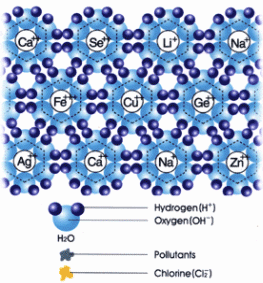
Healthier
Cells - supported by
tightly bonded, hexagonal water clusters - created by "structure
making" ions (see above).
Pollutants and toxins are
unable to bond with water
molecules and create toxin accumulation and cellular problems.
Unhealthy
Cells - characterized by loosely bonded, pentagonal or
unstructured water clusters and "structure-breaking" ions (see table
above).
Pollutants and toxins can
easily bond with water molecules
and create toxic accumulation and cellular problems.
Hexagonal Ice Structure
The Cleaning Side of
Medicine
by Yunjo Chung M.D. |
Mosaic Press; ISBN: 0880140844
Contents:
1. Living Water
2.
Living Water and Dead Water
3. How to Oxygenate Water
4. Water Chunging
5. Water and Aging
Living Water
Everyone has to constantly refill his
or her body with water.
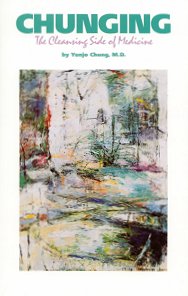 Humans have lived 81 days
without food but will die in 5 days without water. If a person loses 5% of
his total water, he will start to hallucinate, become disoriented, and
experience twitching muscles. If he loses 15% of his total water, his life
is endangered.
Humans have lived 81 days
without food but will die in 5 days without water. If a person loses 5% of
his total water, he will start to hallucinate, become disoriented, and
experience twitching muscles. If he loses 15% of his total water, his life
is endangered.
I know how annoying the advice to drink water
may seem. Many of my younger patients, those in their teens and early
twenties, become annoyed when I tell them to "drink lots of water." Why?
Because throughout their entire lives, they have heard nothing good about
water. Newspapers and magazines have been constantly telling them that their
water is contaminated and dirty. This negative publicity also causes their
teachers and parents to worry about the quality of drinking water.
Simultaneously with this bad publicity about
water, these people have been bombarded with glorious propaganda concerning
soft drinks, coffee, tea, and beer. Ads imply that if you drink their
product, you will be healthy and beautiful like the people in the
photograph. Commercials make it seem like drinking the right beer will make
you popular and happy. They almost always show a group of people having fun
while drinking their brand of beer. The reality of a neighborhood bar is
often quite different. Bars are full of lonely people. Laughter is few and
far between. Even smiles are rare.
If they stop to think about it, most people realize that soft drinks are
harmful. But apart from realizing that sugar and caffeine are not good, they
do not really understand why soft drinks are so bad for their health.
The main difference between water and soda pop
is that good drinking water has oxygen in it and soda has dissolved carbon
dioxide gas under pressure, which forms the bubbles when you open the can or
bottle.
A person breathes in oxygen and exhales carbon
dioxide. Carbon dioxide, like urine and feces, is one of the waste products
of the human body. Drinking carbonated beverages adds large quantities of
the very chemical the body is trying to get rid of.
If you take carbon dioxide into your system,
your body tissue will absorb it. There just isn't room for both the carbon
dioxide and the amount of oxygen each cell needs. The carbon dioxide pushes
some of the oxygen out of the cell. The result is that the cell which is
exposed to carbon dioxide goes through temporary hypoxia-lack of
oxygen-which induces faulty metabolism. This eventually results in diseased
organs.
Drinking soda keeps people from drinking water
when they are thirsty. Soft drinks are harmful to your health because they
do not cleanse your body's cells. Instead, chemicals in soda pop are
accumulated within the cells as harmful waste products.
When I tell my patients that drinking water
will help them stay healthy, some of them ask incredulously, "Do you mean
Cincinnati water?" Yes, I mean regular, Cincinnati tap water. Then my
patients tell me how contaminated city tap water is, and that it causes
cancer. If you go to any large city, most of the residents of that city will
tell you that they have the dirtiest water in the U.S.A. Somehow, the media
has convinced the majority of citizens that their water is too contaminated
to drink.
I don't understand why these people believe
that adding coffee, tea or other chemicals to their tap water will make the
tap water any safer. The mixtures of chemicals in drinks actually add
contaminants to the water.
Most people have all kinds of romantic pictures
in their minds. They like to think that soft drinks are made from sparkling,
splashing water which comes bubbling up from a pure spring somewhere far
away in the mountains. They may imagine that there is a mystical fountain in
a beautiful cave deep within Mother Earth where the bottlers go to make
their delicious concoctions.
Some brewers and bottlers might use spring
water carted in from some other location, but it's not likely-if it raised
the cost of production much, they wouldn't spend the money. The vast
majority of water used in making soft drinks comes either from the city
water supply or from wells at the brewery, cannery, or bottling facility
wells which draw from the same aquifer as all the other wells in the
community. City water comes from wells, springs, lakes, reservoirs, or from
river water. If pollutants exist in the supply, it goes right into the
bottled or canned product.
Whatever the source, anything that was in the
water which was used in making soft drinks and beer, is still in it when you
drink it. These drink manufacturers have added still more chemicals to make
their products.
Rivers or reservoirs are sometimes contaminated
with chemical spills, but a city's water is constantly tested by the
engineers of the water department. Rural areas' water supplies are
periodically checked by the counties. The counties are checked by the state.
The Environmental Protection Agency also monitors the water all over the
country to ensure the safety of the water supply. I don't think that the
E.P.A. would allow people to drink anything as toxic as the media would lead
us to believe.
Only water can clean waste products and toxic
chemicals out of the body and out of the brain. If a person does not
eliminate these waste products, it will cause disease and will alter his
behavior in some way, sooner or later.
For example, since 1960, Americans' intake of
soft drinks has increased and their intake of water has decreased. Also, due
to air conditioning, Americans perspire less than they did in the past.
During this time, the divorce rate has increased greatly, the quality of
U.S. products has worsened, and the
rate of drug abuse has increased. Of course, there are other reasons why
these things have occurred. However, I believe the fact that Americans have
greatly increased their intake of poisonous chemicals has played a major
role in these phenomena.
Another example can be found in the
fast-growing country of Korea. Until the 1980s, the Korean people were too
poor to afford soft drinks. They were forced, financially, to drink water.
Also, due to almost no air conditioning and a lack of cars, Koreans
generally perspired heavily. During this time, their brains were very
'clean' family bonds were tight, Korean industry was booming, and children
were doing well in school. As Korea became richer, more problems developed.
Now, in Korea, most people prefer soft drinks, many houses have air
conditioning, and cars are becoming more easily accessible. The divorce rate
is now climbing. Student protests are more violent than ever before, the
crime rate is skyrocketing, and criminals are becoming more vicious. Workers
do not wish to work, and employers do not wish to share. Again, the causes
of these problems are complicated, but I believe that chemical intake and
improper internal cleansing have been major factors.
A patient of mine who is an experienced grade
school teacher told me that she used to spend her time teaching but now she
feels stressed and angry as she has to spend most of her time keeping the
students quiet and seated at their desks. She is depressed that she has so
little time to teach them their lessons. I believe these bad actions on the
part of the students are the result of the chemicals we parents introduce
into their fragile brains by allowing children to drink soft drinks and to
eat junk food loaded with artificial ingredients.
Living
Water and Dead Water
Most Oriental health books recommend that you
drink 'living water' but never explain exactly what they mean. If you visit
Seoul, Korea, you will see thousands of people awake in the early morning,
5:00 to 6:00 A.M., climbing nearby mountains for 30 to 60 minutes before
going about their daily work. They go to the mountains to drink fountain
water for better health. Most of them start this practice when they become
sick. After doing this daily, many find that their illness begins to
disappear and they become healthier. Because they feel good, they continue
this morning routine.
To me this makes a lot of sense-walking daily
for 30 to 60 minutes, breathing fresh mountain air, then drinking clean,
uncontaminated, oxygenated fountain water. This is a good practice for
anyone searching for better health. Koreans call this uncontaminated
fountain water 'living water,' its traditional name. The following are the
definitions of living water and dead water: Living water is water which is
compatible with life Freshwater fish can live in it. It is the fresh rain
water that sprinkles your garden. It is water which may contain some
minerals but which certainly contains oxygen.
Dead water is water which is not compatible
with life. Distilled water and carbonated water are dead waters because fish
die in them, even though those waters have no impurities. Plants, also,
cannot live on dead water. What causes the contradictory natures of
essentially the same water is the amount of oxygen in the water. Water which
contains the proper amount of oxygen is not harmful to fish and plants.
Water which contains too little oxygen will kill those same fish and plants.
When you put fish in water which has been boiled and cooled, the fish will
die because boiling has removed the oxygen from the water.
How to Oxygenate Water
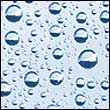 If you
don't have a bubbling fountain, you can easily cause oxygen to dissolve in
water by stirring it in a blender, or by shaking it fill a container about
half full of water, put on a tight lid, and shake the container. This will
properly saturate the water with oxygen to the right concentration.
If you
don't have a bubbling fountain, you can easily cause oxygen to dissolve in
water by stirring it in a blender, or by shaking it fill a container about
half full of water, put on a tight lid, and shake the container. This will
properly saturate the water with oxygen to the right concentration.
One of the basic principles of homeopathy is
that small quantities of medicines should be succussed; that is, medicines
should be diluted and shaken. Homeopathic physicians observed, over the
years, that this diluted and shaken medicine works better and they say this
'vitalizes' the drugs. I believe that the importance of shaking is to add
beneficial oxygen to the mixture, as well as stirring up the contents.
I truly believe that before you drink water,
you should shake it. If you do as I have described, your digestion as well
as your general health will improve and you will be more resistant to
diseases. You must not expect immediate results, but over the years it will
benefit you. Many of the chemical processes which take place in the stomach
and small intestine run more efficiently if there is enough oxygen present.
Therefore, drinking living water also helps digestion.
Water
Chunging
I recommend drinking six to ten eight-ounce
cups of water per day for the average person, depending on their weight.
You must remember to balance the intake and
output of water. Taking in too much water is as dangerous as dehydration. A
person can become intoxicated by over-hydration. He will experience nausea,
weakness, dizziness, trembling hands, cramping, and eventually would lose
consciousness. You should not drink over twelve eight-ounce glasses (about
3000 cc) of water a day, except under special conditions.
One important rule of good health is "do not
overdo," or "everything in moderation.". Even something known to be good for
health can be dangerous if taken in too large quantities. Water, vital to
life, can be harmful if consumed in excess.
Water
and Aging
Doctors and researchers know that the main
cause of aging is the accumulation of waste products in the body. The human
body is composed of 100 trillion living cells. Each individual cell works
and lives for you. To do this, each cell takes in nutrients, utilizes those
nutrients, and discharges its waste products. Water then flushes the cells'
waste products away.
The same is true of your whole body. You eat,
digest, and wash away your excretions mainly with the help of water. When
you wash your clothes, you fill your washer with water, not soft drinks,
coffee, tea, or juice. Water is the only thing that can clean your clothes.
The same mechanism applies to cleaning your body's cells. Only proper
amounts of water can clean your body's cells.
I have encountered many people who take pride
in saying, "I never sweat," or "I never drink water." I have observed that
these people appear much older after the age of forty than people who sweat
and drink water. By the age of fifty, many of them have become afflicted by
arthritis or other 'incurable' diseases. Doctors can't completely cure these
diseases because they don't yet know the causes.
When I meet people who are seventy-five and
look twenty years younger, invariably I find that they sweat regularly and
drink water. In my opinion drinking plenty of water prevents the buildup of
toxic waste in the body, thus expelling the cause of many diseases. Drinking
lots of water also slows down the set of symptoms which we generally refer
to as aging.
The cause of Alzheimer's disease is unknown at
present. Researchers are aware that the nerve cells of people affected by
this disease contain large amounts of unusual waste chemicals which
eventually destroy the nerve cells. Eventually the number of nerve cells in
the brain becomes drastically reduced, which causes the diminished abilities
of thought and speech.
The brain lives in a liquid environment. I
believe that, since drinking water minimizes waste accumulation in the
brain, it can also help prevent Alzheimer's disease and other brain
abnormalities. I wonder how people expect to clean their brain cells without
enough water.
The environmental liquid with which the brain
is surrounded is called spinal fluid. One of the signs of a fractured skull
is some of this clear liquid leaking out of the ears. A spinal tap is also
used to draw a small amount of this vital fluid in order to test for some
brain diseases such as spinal meningitis. I only mention these things here
to reinforce how important I believe it is to keep your brain clean by a
constant intake of the most vital of thing of all-water.
Drinking enough water is an
every-day-of-your-life thing. It is the essential ingredient for making all
the Chunging exercises work for you. And like the other exercises I
recommend, it is never too late to start drinking the proper amount of
water; at any age, your body will definitely benefit.
 Author:
Dr. Chung was educated in Korea, completing his M.D. in 1963 from
the University of Korea. He came to the United States for further
medical training in 1966. He is Board certified in Obstetrics and
Gynecology since 1973. By that time, he had fallen in love with America,
and he and his wife became citizens of the United States. He wants to
contribute to the betterment of his beloved adopted country by teaching
people to cleanse away the cause of disease to prevent and cure illness
and to keep them functionally fit their whole lives. Author:
Dr. Chung was educated in Korea, completing his M.D. in 1963 from
the University of Korea. He came to the United States for further
medical training in 1966. He is Board certified in Obstetrics and
Gynecology since 1973. By that time, he had fallen in love with America,
and he and his wife became citizens of the United States. He wants to
contribute to the betterment of his beloved adopted country by teaching
people to cleanse away the cause of disease to prevent and cure illness
and to keep them functionally fit their whole lives.
|
SOURCE

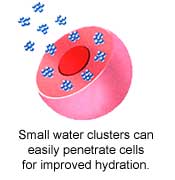
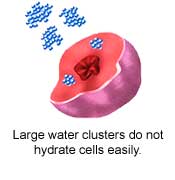
 Hexagonal
Water is a specific arrangement of
individual water molecules where 6 H2O units consistently link to form a
ring-like structure. This unique arrangement is the basis of a more
complex crystalline network that is formed when numerous hexagonal units
join together.
Hexagonal
Water is a specific arrangement of
individual water molecules where 6 H2O units consistently link to form a
ring-like structure. This unique arrangement is the basis of a more
complex crystalline network that is formed when numerous hexagonal units
join together.




 Humans have lived 81 days
without food but will die in 5 days without water. If a person loses 5% of
his total water, he will start to hallucinate, become disoriented, and
experience twitching muscles. If he loses 15% of his total water, his life
is endangered.
Humans have lived 81 days
without food but will die in 5 days without water. If a person loses 5% of
his total water, he will start to hallucinate, become disoriented, and
experience twitching muscles. If he loses 15% of his total water, his life
is endangered. If you
don't have a bubbling fountain, you can easily cause oxygen to dissolve in
water by stirring it in a blender, or by shaking it fill a container about
half full of water, put on a tight lid, and shake the container. This will
properly saturate the water with oxygen to the right concentration.
If you
don't have a bubbling fountain, you can easily cause oxygen to dissolve in
water by stirring it in a blender, or by shaking it fill a container about
half full of water, put on a tight lid, and shake the container. This will
properly saturate the water with oxygen to the right concentration.
